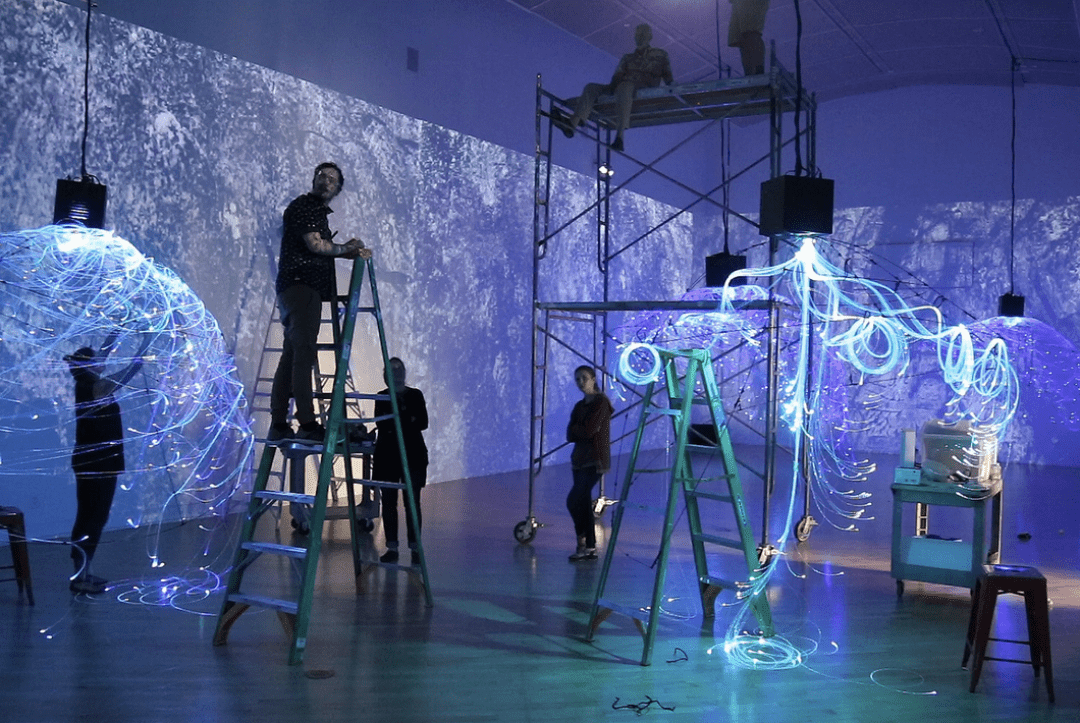MSU team brings immersive CAVE experience to campus Jan. 25-April 5
Tuesday Jan. 22nd, 2019

Humans made the first paintings and musical sounds in caves more than 35,000 years ago, and now a collaboration of Montana State University faculty and staff across campus is putting a contemporary and imaginative spin on the ancient art forms.
The NeuroCave Collaborative, an MSU-based interdisciplinary team made up of faculty and staff, created CAVE, an interactive, “artscience” installation that opens at 4 p.m. Friday, Jan. 25, in room 149 of Norm Asbjornson Hall. It will be on display through April 5.
Organizers said this is the first installation of CAVE on the MSU campus, which was first installed more than a year ago at the Holter Museum in Helena. The MSU installation, which is free and open to the public, is part of a set of events celebrating the opening of the new Norm Asbjornson Hall.
Members of the NeuroCave Collaborative include Sara Mast, art, John Miller, professor emeritus of neuroscience; Jessica Jellison and Bill Clinton, architecture; Linda Antas and Jason Bolte, music; Dave Millman and Brittany Fasy, computer science; Chris Huvaere, MSU Techlink; and Zach Hoffman, photography. Barry Anderson, an artist and professor at the University of Missouri at Kansas City, also participated.
Mast said the exhibit blurs the line between artist and participant, which is exciting. “When you are in the neuro-cave form with the headset on, you are the artist,” she said.
Mast said she got the idea for CAVE after she attended a lecture on cave art and neuroscience given by Miller about nine years ago. Miller had discussed how sensory deprivation in caves — the lack of light and oxygen specifically — apparently causes a common neurological reaction in humans that could explain the phenomenon of similar designs found in cave art around the world.
Over four years ago, she met with Jellison and Bolte, two faculty members with whom she had collaborated previously on the MSU artscience installation Black (W)hole, a work celebrating Albert Einstein. Ultimately, the resulting NeuroCave Collaborative was formed. The idea grew, as did the number of contributors, eventually giving rise to the CAVE project.
The interactive installation works like this: Participants put on a simple headset that monitors their brainwaves and then walk under one of three neuro-cave forms, which hang in the room. The forms are constructed of carbon fiber rods, 3D-printed connectors and fiber-optic filament. Through the use of neurofeedback transmitted through the headset to a small, hidden computer, the participants generate rhythmic and mesmerizing light and sound that is projected back into the room.
Mast calls the result an “immersive filmic and sonic environment that echoes cultural memory and connects our most rudimentary tools with our most technological ones.”
Additionally, when the computer program receives signals from the headset-wearing participants' brain activity that is similar to others in the room, the sound pulsates and the lights get brighter. The more similar the brainwave activity is, the faster the sound pulses and the brighter the lights. Developers said no data from participants is recorded; the experience is purely artistic and technological.
The installation is a demonstration of diverse MSU talent and expertise. For instance, Clinton, a master fabricator, worked with Jellison and Mast to co-create the neuro-caves, including the plastic connectors that he made in a 3D printer. He said each of the neuro-caves weighs less than a pound.
Bolte composed the ambient soundtrack, a 30-minute loop that includes recordings from the lowest cavern at Lewis and Clark Caverns. Antas programmed the sonification of the brainwave feedback.
Huvaere designed the lighting along a spectrum of cyan to magenta. Millman and Fasy programmed and fine-tuned the headsets and the computer that coordinates the installation. Jellison designed the layout of the space with the goal of making it a 3D, immersive experience, while Mast’s small paintings photographed in her studio were used to generate the surround animation created by Hoffman. Miller, the neuroscientist, guided the science connection between the art, the technology and the participants’ brainwaves.
The NeuroCave Collaborative trained MSU student docents who will help guide the visitors in the multi-sensory installation.
Mast said that CAVE taps into the latest technology “but also reminds us of our creative origins—of humanity’s first known images, our first art installations, our first architectural spaces and our first animations in the flickering torchlight of caves.”
The CAVE installation will be open from 9 a.m. to 5 p.m., Monday through Friday, through April 5. To learn more about CAVE see: http://www.montana.edu/cave/video.html.
| Tweet |